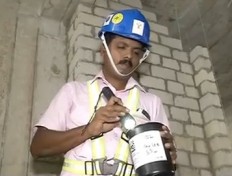
Photo courtesy of Oxitec
A laboratory in the UK has taken a novel approach to helping reduce the spread of dengue: developing a genetically modified male mosquito whose offspring should in theory never reach maturity.
Dengue is only spread through bites from the female of its primary vector, the Aedes aegypti mosquito. Oxford-based Oxitec has added two extra genes to male mosquitoes. These males are released into the wild where females mate with them. Their offspring inherit the extra genes, which are intended to cause them to die before reaching adulthood. They are also born with a marker to identify them under a special light.
The approach is based on the premise that a reduction in the mosquito population will contribute to a reduction in the spread of the disease. Current field trials in Panama aim to build on ongoing trials in Brazil (and earlier trials in Malaysia and the Cayman Islands), assessing the safety and effectiveness of this approach in different environments.
Understanding the local context
Oxitec is collaborating with local partners in some areas of the world hardest hit by dengue. We spoke to Dr. Andrew McKemey, Head of Field Operations at Oxitec, about the technology and how they are working with local organizations to stop the spread of dengue.

Photo courtesy of Oxitec
The company’s work in Brazil, for example, began through collaboration with Dr. Margareth Capurro at the University of São Paulo. Today, Oxitec and the University are working with social nonprofit organization Moscamed to reduce the Aedes aegypti population in cities in the state of Bahia in eastern Brazil. “We are working with local collaborators and they are really key to what we do because we have to think about the cultural context in the different countries we are working in,” Dr. McKemey told us.
Transparency and engagement vital
The Oxitec insects are receiving a lot of attention on the international stage, from the research community and NGOs in particular. “We are doing something new, so there is a lot of attention and we have to be totally transparent,” notes Dr. McKemey.
At a local level, transparency is key to success too. It is vitally important that the people in the villages where the modified mosquitoes are released fully understand the work Oxitec is doing. Dr. McKemey explains their approach to working with the local community: “We have extensive community engagement programs with all our projects. We go door-to-door, hold town hall meetings, visit schools, all kinds of things. In Brazil, where they are really into their carnivals, we had people dressed as mosquitoes handing out leaflets.”
Resistance reflects dengue experience
Most places where Oxitec is working have a significant problem with mosquitoes and people are keen to see them brought under control. In places like Malaysia and Brazil, where dengue is a very apparent problem, people are very supportive.

Photo courtesy of Oxitec
However, in places such as the Cayman Islands – where Oxitec did its first work – dengue isn’t endemic. “Technologies such as this are more about stopping dengue coming in and gaining a foothold,” Dr. McKemey notes. “There isn’t as much first-hand experience of what dengue means, so there can be more resistance from locals who don’t foresee the problems.”
Alleviating concerns
“One of the most common concerns,” he continues, “is about the ecosystem. But Aedes aegypti originated in Africa so in most places around the world – and all the places we are working – it’s not indigenous.”

Photo courtesy of Oxitec
Another concern is that some modified mosquitoes could feed on waste containing tetracycline (an antidote for the effect of the additional genes), enabling the offspring to survive and pass on their GM traits.
To date, Oxitec has studied over 100 generations of its GM mosquitos, but the longer-term safety and efficiency of this approach still remains to be proven. The continuing field tests – including the ongoing releases in Brazil and Panama, and the planned releases in Florida Keys, which will be described in our next post – will answer some of the questions raised.



 Because they are so vast in number, catching mosquitoes isn’t an easy (or cheap) task. In Singapore, the
Because they are so vast in number, catching mosquitoes isn’t an easy (or cheap) task. In Singapore, the 





 This year Brazil hosts the 20th
This year Brazil hosts the 20th 
 What’s the best way to combat dengue? Prevention is better than cure, but how can we prevent the spread of the disease?
What’s the best way to combat dengue? Prevention is better than cure, but how can we prevent the spread of the disease? It’s hoped that the law can prove a powerful tool to combat dengue. But while legislation is important, can it really work without also educating people about dengue?
It’s hoped that the law can prove a powerful tool to combat dengue. But while legislation is important, can it really work without also educating people about dengue?  Dengue isn’t a disease that only happens somewhere else. Public healthcare officials in Texas had a stark reminder of this in late 2013, when
Dengue isn’t a disease that only happens somewhere else. Public healthcare officials in Texas had a stark reminder of this in late 2013, when